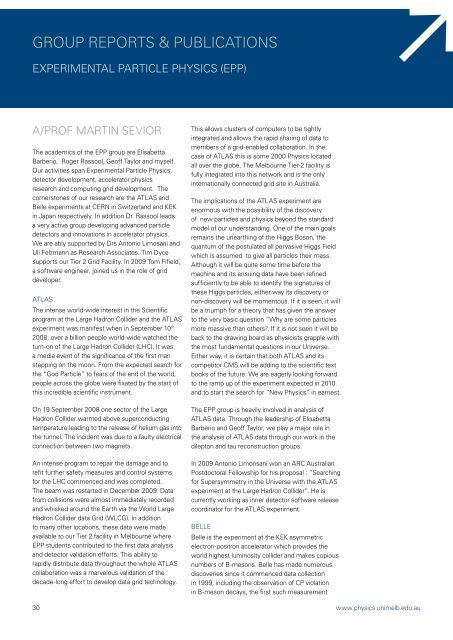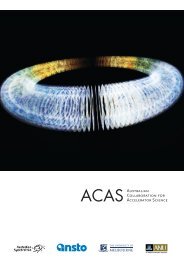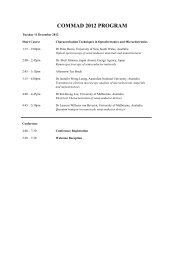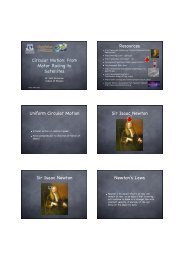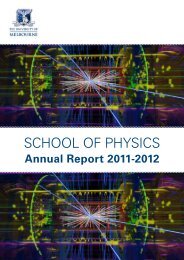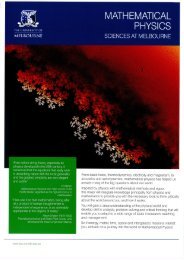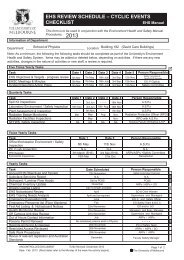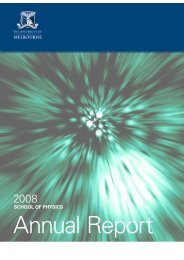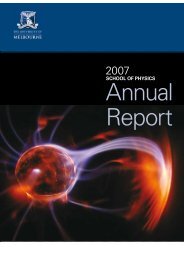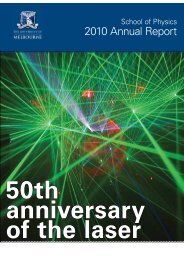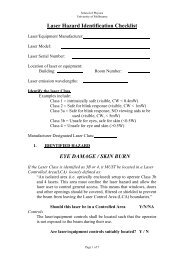Annual Report 2009.pdf - School of Physics - University of Melbourne
Annual Report 2009.pdf - School of Physics - University of Melbourne
Annual Report 2009.pdf - School of Physics - University of Melbourne
- No tags were found...
Create successful ePaper yourself
Turn your PDF publications into a flip-book with our unique Google optimized e-Paper software.
group reports & publicationsexperimental particle physics (EPP)A/Pr<strong>of</strong> Martin SeviorThe academics <strong>of</strong> the EPP group are ElisabettaBarberio, Roger Rassool, Ge<strong>of</strong>f Taylor and myself.Our activities span Experimental Particle <strong>Physics</strong>,detector development, accelerator physicsresearch and computing grid development. Thecornerstones <strong>of</strong> our research are the ATLAS andBelle experiments at CERN in Switzerland and KEKin Japan respectively. In addition Dr. Rassool leadsa very active group developing advanced particledetectors and innovations in accelerator physics.We are ably supported by Drs Antonio Limosani andUli Felzmann as Research Associates. Tim Dycesupports our Tier 2 Grid Facility. In 2009 Tom Fifield,a s<strong>of</strong>tware engineer, joined us in the role <strong>of</strong> griddeveloper.ATLASThe intense world-wide interest in the Scientificprogram at the Large Hadron Collider and the ATLASexperiment was manifest when in September 10 th2008, over a billion people world-wide watched theturn-on <strong>of</strong> the Large Hadron Collider (LHC). It wasa media event <strong>of</strong> the significance <strong>of</strong> the first manstepping on the moon. From the expected search forthe “God Particle” to fears <strong>of</strong> the end <strong>of</strong> the world,people across the globe were fixated by the start <strong>of</strong>this incredible scientific instrument.On 19 September 2008 one sector <strong>of</strong> the LargeHadron Collider warmed above superconductingtemperature leading to the release <strong>of</strong> helium gas intothe tunnel. The incident was due to a faulty electricalconnection between two magnets.An intense program to repair the damage and torefit further safety measures and control systemsfor the LHC commenced and was completed.The beam was restarted in December 2009. Datafrom collisions were almost immediately recordedand whisked around the Earth via the World LargeHadron Collider data Grid (WLCG). In additionto many other locations, these data were madeavailable to our Tier 2 facility in <strong>Melbourne</strong> whereEPP students contributed to the first data analysisand detector validation efforts. This ability torapidly distribute data throughout the whole ATLAScollaboration was a marvelous validation <strong>of</strong> thedecade-long effort to develop data grid technology.30This allows clusters <strong>of</strong> computers to be tightlyintegrated and allows the rapid sharing <strong>of</strong> data tomembers <strong>of</strong> a grid-enabled collaboration. In thecase <strong>of</strong> ATLAS this is some 2000 <strong>Physics</strong> locatedall over the globe. The <strong>Melbourne</strong> Tier-2 facility isfully integrated into this network and is the onlyinternationally connected grid site in Australia.The implications <strong>of</strong> the ATLAS experiment areenormous with the possibility <strong>of</strong> the discovery<strong>of</strong> new particles and physics beyond the standardmodel <strong>of</strong> our understanding. One <strong>of</strong> the main goalsremains the unearthing <strong>of</strong> the Higgs Boson, thequantum <strong>of</strong> the postulated all pervasive Higgs Fieldwhich is assumed to give all particles their mass.Although it will be quite some time before themachine and its ensuing data have been refinedsufficiently to be able to identify the signatures <strong>of</strong>these Higgs particles, either way its discovery ornon-discovery will be momentous. If it is seen, it willbe a triumph for a theory that has given the answerto the very basic question “Why are some particlesmore massive than others?. If it is not seen it will beback to the drawing board as physicists grapple withthe most fundamental questions in our Universe.Either way, it is certain that both ATLAS and itscompetitor CMS will be adding to the scientific textbooks <strong>of</strong> the future. We are eagerly looking forwardto the ramp up <strong>of</strong> the experiment expected in 2010and to start the search for “New <strong>Physics</strong>” in earnest.The EPP group is heavily involved in analysis <strong>of</strong>ATLAS data. Through the leadership <strong>of</strong> ElisabettaBarberio and Ge<strong>of</strong>f Taylor, we play a major role inthe analysis <strong>of</strong> ATLAS data through our work in thedilepton and tau reconstruction groups.In 2009 Antonio Limonsani won an ARC AustralianPostdoctoral Fellowship for his proposal : “Searchingfor Supersymmetry in the Universe with the ATLASexperiment at the Large Hadron Collider”. He iscurrently working as inner detector s<strong>of</strong>tware releasecoordinator for the ATLAS experiment.BelleBelle is the experiment at the KEK asymmetricelectron-positron accelerator which provides theworld highest luminosity collider and makes copiousnumbers <strong>of</strong> B-mesons. Belle has made numerousdiscoveries since it commenced data collectionin 1999, including the observation <strong>of</strong> CP violationin B-meson decays, the first such measurementwww.physics.unimelb.edu.au


